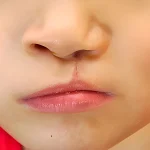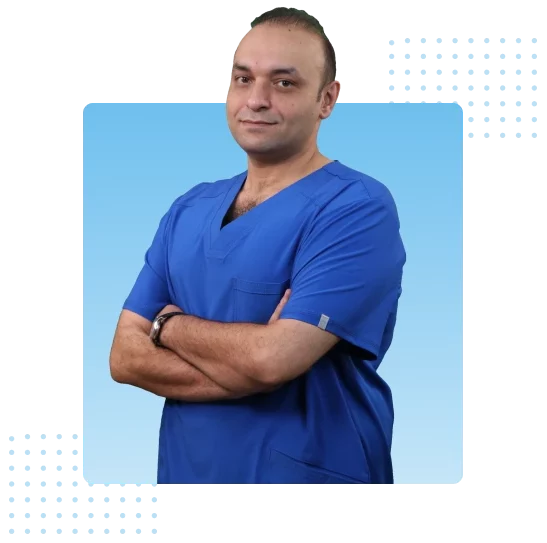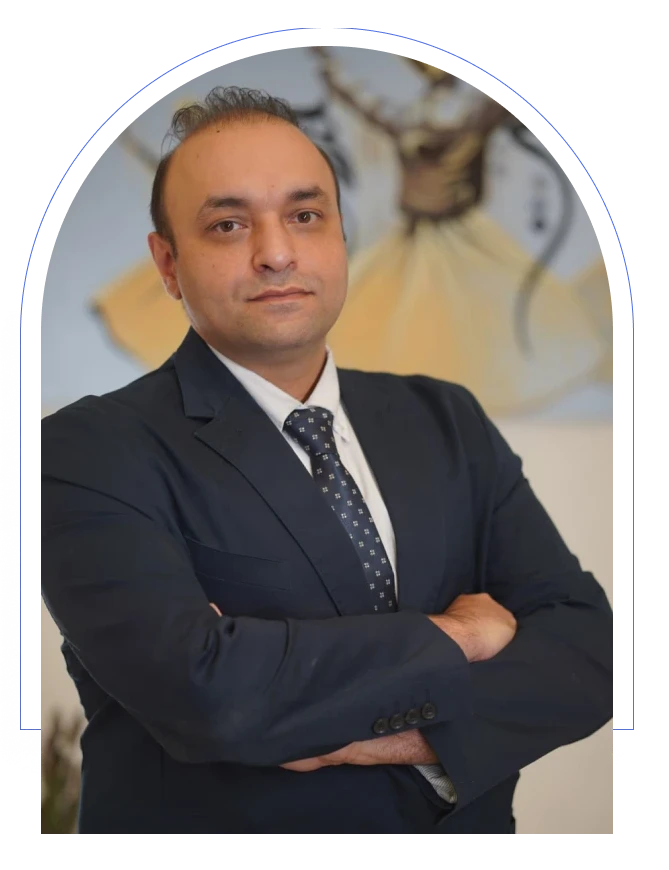A cleft lip is one of the most common congenital conditions, affecting the development of a child’s upper lip and, consequently, the structure and function of their nose. While initial surgeries in infancy work to repair the lip, the associated nasal deformities often require specialized attention later in life. This challenge is addressed by cleft lip and rhinoplasty, a highly specialized field of plastic surgery dedicated to correcting both the appearance and function of the nose affected by a cleft lip.
For parents and patients navigating this journey, the path can seem complex. This comprehensive guide is designed to provide clarity and reassurance, explaining the surgical approaches, benefits, and recovery process associated with cleft lip nose surgery. Understanding these elements is the first step toward restoring facial harmony, improving quality of life, and building unshakable confidence.
What Is a Cleft Lip and Why Does It Affect the Nose?
To appreciate the role of rhinoplasty in cleft lip repair, it’s essential to first understand the condition itself and its profound impact on facial anatomy, particularly the nasal structures.
Understanding Cleft Lip Deformity
A cleft lip is a physical separation of the two sides of the upper lip, which appears as a narrow opening or gap. This congenital anomaly occurs very early in pregnancy when the tissues that form the lip and roof of the mouth do not fuse properly. The condition can range in severity from a small notch in the lip to a complete separation extending up into the nose. It can occur on one side of the lip (unilateral) or both sides (bilateral).
This incomplete fusion disrupts the muscular, skeletal, and soft tissue foundation of the midface, creating a chain reaction that directly impacts the nose.
Impact of Cleft Lip on Nasal Structure and Function
The nose and the upper lip are intricately connected. When a cleft lip forms, this connection is disrupted, leading to a characteristic set of nasal asymmetries and functional issues known as a cleft lip nasal deformity.
Common features include:
- Asymmetrical Nostrils: The nostril on the side of the cleft is often wider, flatter, and positioned lower than the other.
- Deviated Septum: The wall of cartilage and bone that divides the nasal passages (the septum) is almost always crooked, leading to a tilted appearance and significant breathing difficulties.
- Flattened Nasal Tip: The cartilage that shapes the tip of the nose on the cleft side is underdeveloped and poorly supported, causing it to appear slumped or flat.
- Short Columella: In bilateral cleft lip cases, the strip of tissue between the nostrils (the columella) is often extremely short, pulling the nasal tip down and making it appear wide.
- Weak Nasal Base: The floor of the nose on the cleft side lacks proper skeletal support from the upper jaw, contributing to the overall lack of symmetry.
These structural issues are not merely cosmetic; they directly lead to functional problems, most notably a compromised nasal airway function, making it difficult to breathe through one or both sides of the nose.
What Is Cleft Lip Rhinoplasty?
Cleft lip rhinoplasty is a specialized surgical procedure designed to correct the nasal deformities resulting from a cleft lip. It goes far beyond a standard cosmetic rhinoplasty, requiring a deep understanding of the complex anatomical challenges and a meticulous approach to cleft lip reconstructive surgery.
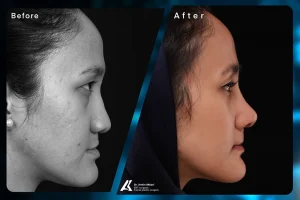
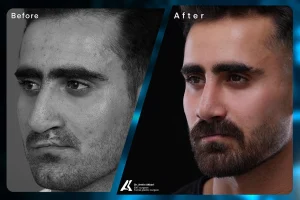
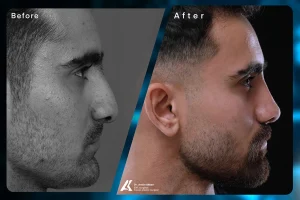
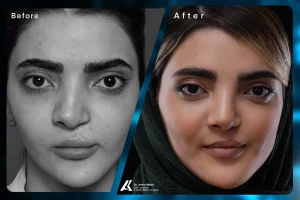
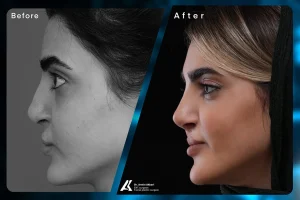
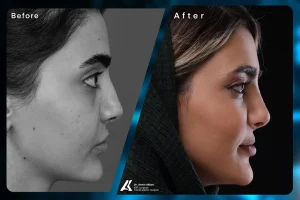
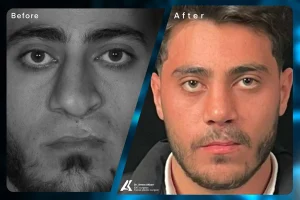
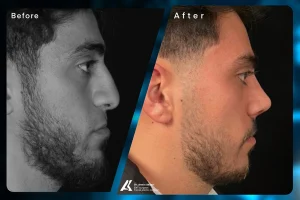
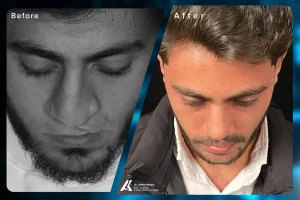
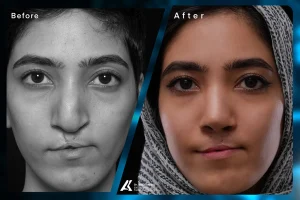
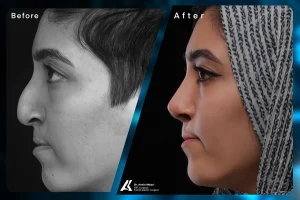
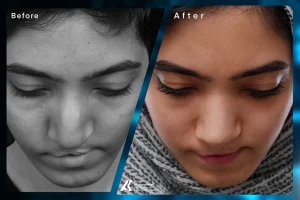
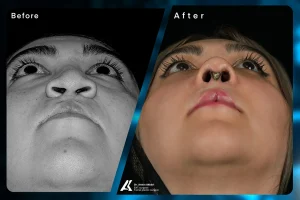
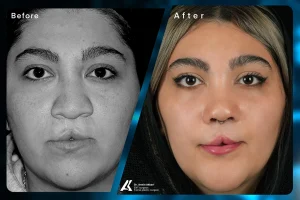
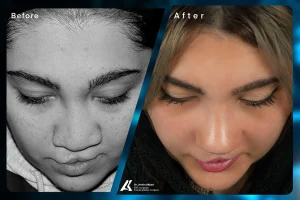
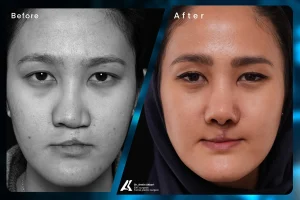
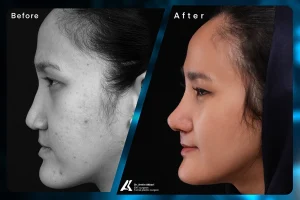
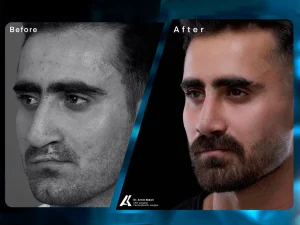
Purpose of Rhinoplasty in Cleft Lip Patients
The primary goals of the cleft lip rhinoplasty procedure are twofold: functional and cosmetic.
- Functional Restoration: The foremost objective is to improve breathing. This involves straightening the deviated septum (a procedure called septoplasty), supporting the nostrils to prevent collapse, and ensuring clear nasal passages.
- Aesthetic Improvement: The second goal is to create a more symmetric, balanced, and natural-looking nose. This enhances facial harmony, which can have a profound positive impact on a patient’s self-esteem.
Differences Between Primary vs. Secondary Cleft Rhinoplasty
The correction of the cleft nasal deformity is often a staged process, with surgeries performed at different points in a patient’s life.
- Primary Cleft Rhinoplasty: This is an initial nasal correction performed at the same time as the primary cleft lip repair, typically when a child is between 3 and 6 months old. The goal is not a definitive correction but rather to reposition the nasal cartilages into a more anatomical position. This early intervention helps guide the nose’s growth in a more symmetrical pattern, potentially reducing the severity of the deformity and making future surgeries more straightforward.
- Secondary Cleft Rhinoplasty: This is a more formal and definitive cleft lip nose surgery performed after the initial lip repair, once the face has undergone significant growth. It can be categorized further:
- Intermediate Rhinoplasty: Performed in early childhood (around 4-6 years old) to address significant asymmetries before a child starts school.
- Definitive Rhinoplasty: This is the most comprehensive procedure, performed when the patient has reached skeletal maturity (typically in the mid-to-late teenage years, around 15-18). By this age, facial growth is largely complete, allowing the surgeon to make permanent structural changes with predictable, lasting results.
Surgical Techniques and Approaches of Cleft lip and Rhinoplasty
Performing a successful cleft lip nasal deformity correction requires a surgeon to master a wide array of advanced techniques. The approach is highly customized to each patient’s unique anatomy and goals.
Timing of Surgery (Childhood vs. Adulthood)
The timing of definitive rhinoplasty is critical. Performing surgery too early, before facial growth is complete, can interfere with the natural development of the nose and midface, potentially leading to stunted growth and requiring further revisions. Waiting until the mid-to-late teens ensures that the nasal structures are stable, allowing for a predictable and permanent outcome.
However, some adults who had their initial lip repair in childhood may seek cleft rhinoplasty for the first time later in life. These procedures can be more challenging due to scar tissue from the original surgery and the rigidity of mature cartilage, but significant improvements are still achievable in the hands of an experienced surgeon.
Functional Correction (Breathing, Septum Repair)
For many patients, the most life-changing aspect of the surgery is the ability to breathe freely through their nose. Functional correction is the foundation of cleft rhinoplasty. Key techniques include:
- Septoplasty: The surgeon carefully straightens the deviated septum, repositioning it in the midline of the nose. This immediately opens up the nasal passages.
- Cartilage Grafting: To support the newly straightened septum and prevent it from deviating again, the surgeon often uses cartilage grafts. These grafts, typically harvested from the patient’s own septum, ear, or in some cases, a rib, act as internal splints or support beams.
- Spreader Grafts: These small, rectangular cartilage grafts are placed between the septum and the upper lateral cartilages of the nose to open the internal nasal valve, the narrowest part of the airway, further improving airflow.
Aesthetic Refinements (Symmetry, Tip Projection, Nostril Shape)
Once the functional framework is established, the surgeon focuses on the art of aesthetic refinement. The goal is to create a nose that is not only symmetric but also in harmony with the patient’s other facial features.
- Tip Refinement and Projection: Using sophisticated cartilage grafting and suturing techniques, the surgeon rebuilds and repositions the flattened nasal tip cartilages to create better definition and projection (how far the tip sticks out from the face). A columellar strut graft is often used to provide vertical support.
- Nostril Reshaping: The wider, slumped nostril on the cleft side is repositioned, reshaped, and resized to better match the non-cleft side. This may involve repositioning the alar base (where the nostril meets the cheek) and using precise incisions to create a more natural nostril shape.
- Augmenting the Nasal Dorsum: In some cases, the bridge of the nose may need to be built up to create a stronger, more defined profile. This is also achieved with carefully carved cartilage grafts.
Benefits of Cleft Lip Rhinoplasty
The decision to undergo functional and cosmetic nose surgery for cleft lip is a significant one, but its rewards can be transformative. In the following sections, we will explore how this procedure impacts physical health, emotional well-being, and overall quality of life.
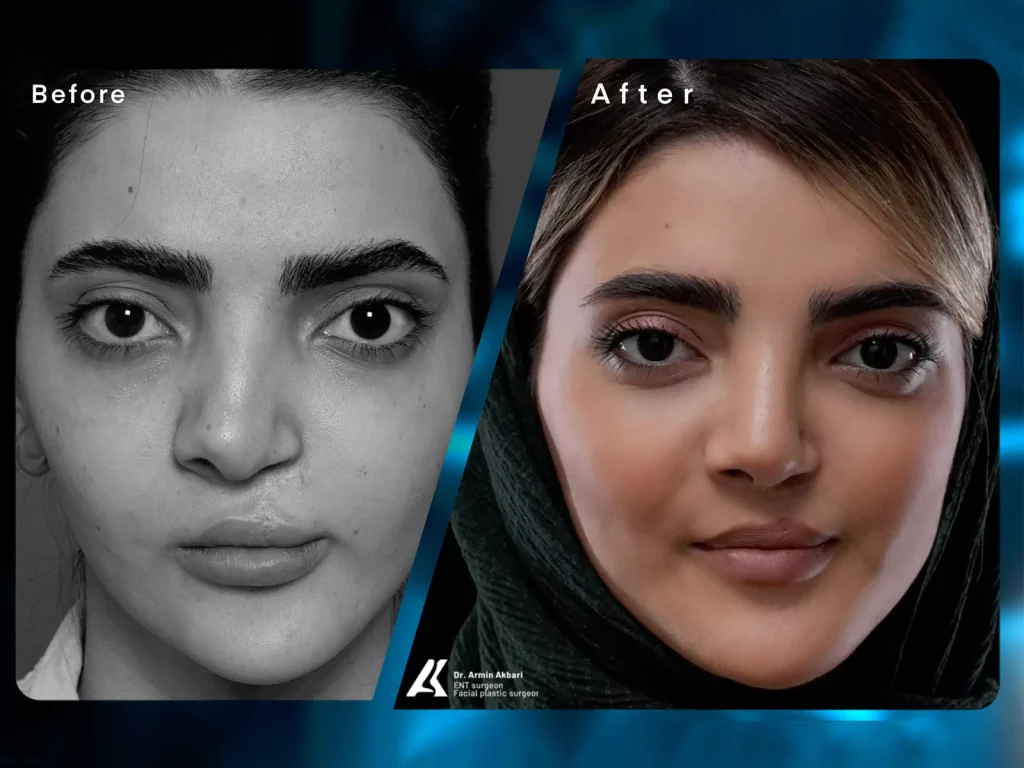
۱. Restoring Nasal Function
The most immediate physical benefit is improved breathing. Patients often report better sleep, increased energy levels, and a greater ability to participate in physical activities. Correcting the nasal airway can also reduce issues like chronic nasal congestion and sinus infections.
۲. Improving Facial Harmony and Aesthetics
While function is paramount, the aesthetic improvements from cleft rhinoplasty cannot be understated. By creating a more symmetric and balanced nose, the surgery brings the entire face into better proportion. This allows a person’s individual features (their eyes, their smile) to become the focus, rather than the asymmetry. The cleft lip rhinoplasty before and after transformations often reveal a natural and refined appearance that looks like the nose they were always meant to have.
۳. Boosting Self-Confidence and Quality of Life
Living with a visible facial difference can take a significant emotional toll, particularly during the formative teenage years. The psychological benefits of cleft rhinoplasty are profound. Patients often experience a dramatic boost in self-confidence and self-esteem. This newfound confidence can positively impact social interactions, academic performance, and professional opportunities, empowering them to lead fuller, more engaged lives.
Recovery and Results of Cleft Lip and Rhinoplasty
Understanding the healing process and setting realistic expectations are crucial for a positive surgical experience.
Healing Timeline and Aftercare
Recovery from cleft rhinoplasty is a gradual process that unfolds over several key stages.
- First Week: A cast or splint will be placed on the outside of the nose, and soft splints may be placed inside. Swelling and bruising around the eyes are normal and will peak in the first few days. Some discomfort is expected and is managed with prescribed pain medication.
- ۱-۲ Weeks: The external cast and internal splints are removed. Most of the bruising will have subsided, and patients can typically return to school or work. Strenuous activities and contact sports should be avoided.
- First Month: The majority of the swelling will resolve, and you will begin to see the initial results. However, the nose will still feel stiff and numb.
- ۶ Months to 1 Year: The healing process continues as the residual swelling slowly disappears and the scar tissue softens. The final, refined result of the surgery will become apparent over this period.
Following your surgeon’s aftercare instructions is vital for a smooth recovery and optimal results.
Expected Outcomes and Limitations
The goal of cleft rhinoplasty is significant improvement, not perfection. Due to the underlying tissue and skeletal asymmetries, achieving perfect symmetry is extremely challenging. However, a skilled surgeon can achieve a result that appears natural, is highly symmetric, and functions beautifully. It’s important to discuss realistic before and after expectations during your consultation.
Choosing the Best Cleft Lip and Rhinoplasty Surgeon
Cleft rhinoplasty is widely considered one of the most complex and demanding procedures in all of facial plastic surgery. The choice of surgeon is the single most important factor in achieving a successful outcome.
Importance of Experience in Cleft Rhinoplasty
A qualified surgeon must have more than just general rhinoplasty experience. They need:
- Subspecialty Training: Look for a surgeon with fellowship training in facial plastic and reconstructive surgery, specifically with a focus on cleft lip and palate.
- A Deep Understanding of Cleft Anatomy: The surgeon must be intimately familiar with the unique structural challenges of the cleft nose.
- Mastery of Advanced Techniques: They must be proficient in complex cartilage grafting and reconstructive methods.
- A Portfolio of Cleft Cases: Ask to see cleft lip rhinoplasty before and after photos of their previous patients.
Why Consult Dr. Armin Akbari?
Dr. Armin Akbari is a board-certified ENT surgeon with subspecialty fellowship training in facial plastic and reconstructive surgery. He possesses a unique combination of technical precision and artistic vision, with a profound dedication to helping patients affected by cleft lip.
Dr. Akbari’s approach is rooted in a deep, compassionate understanding of the patient’s journey. He recognizes that this surgery is about more than just aesthetics; it’s about restoring function, confidence, and a sense of wholeness. By combining his extensive experience in cleft lip reconstructive surgery with the latest, most advanced surgical techniques, he is able to deliver results that are both functionally sound and beautifully natural.
When you choose Dr. Akbari, you are choosing a partner who will listen to your goals, provide an honest assessment, and develop a personalized surgical plan tailored to your unique needs.
Conclusion: Combining Function and Aesthetics for Lasting Results
Cleft lip and rhinoplasty are remarkable procedure that lies at the intersection of science and art. It is a journey that addresses the physical challenges of a compromised airway while simultaneously restoring the aesthetic harmony of the face. For individuals and families affected by cleft lip, it represents the final, powerful step in a long process of reconstruction. This step unlocks a future of easier breathing and renewed self-confidence.
Take the Next Step with an Expert
If you or your child are considering cleft lip rhinoplasty, Dr. Armin Akbari provides expert surgical care that combines precision, artistry, and compassion. Book your consultation today to take the first step toward restored function and confidence.
Frequently Asked Questions (FAQs)
Cleft lip rhinoplasty is a specialized type of nose surgery performed to correct the functional and cosmetic deformities of the nose that result from a cleft lip. Its goals are to improve breathing, increase nasal symmetry, and create a more natural shape.
While an initial nasal procedure may be done during infancy with the lip repair, the definitive, comprehensive rhinoplasty is typically performed once the patient reaches skeletal maturity. This is usually in the mid-to-late teens (around 15-18 years old) to ensure facial growth is complete.
It is both. A primary goal is functional—to correct a deviated septum and improve airflow for better breathing. The cosmetic component focuses on improving the nose’s symmetry, shape, and overall appearance to enhance facial harmony.
Initial recovery, where patients can return to non-strenuous activities, is about 1-2 weeks. However, the nose continues to heal and refine for up to a year. The majority of swelling subsides within the first month, but the final result will emerge over 6-12 months.
The goal of cleft rhinoplasty is to create a significant improvement in symmetry and function. While achieving perfect, 100% symmetry is often not possible due to the complex underlying asymmetries in bone and soft tissue, an experienced surgeon can achieve a very natural, balanced, and harmonious result that appears symmetric to the casual observer.

